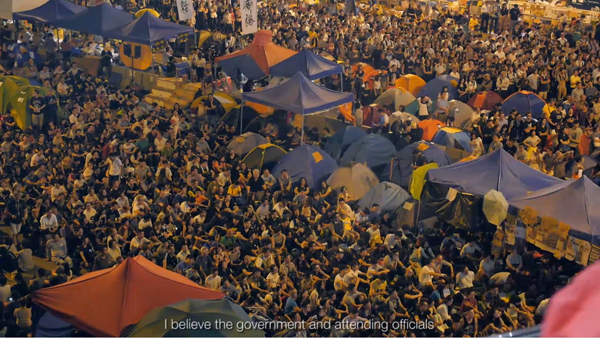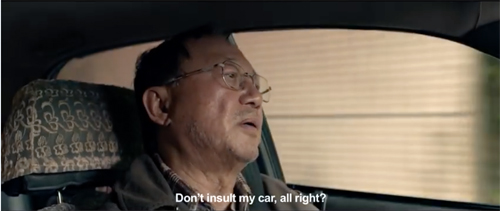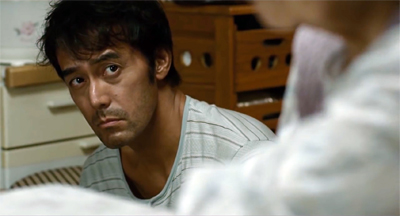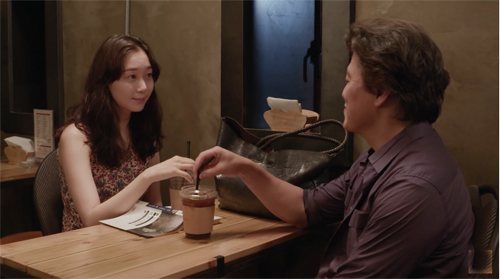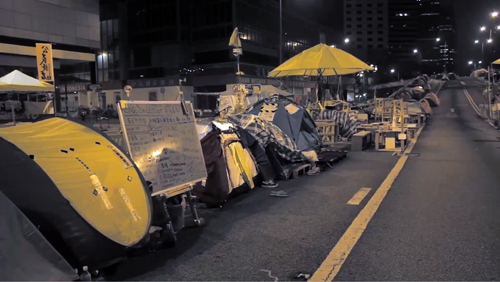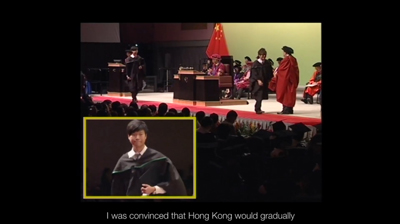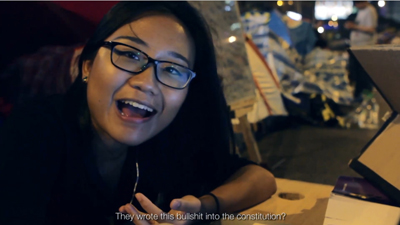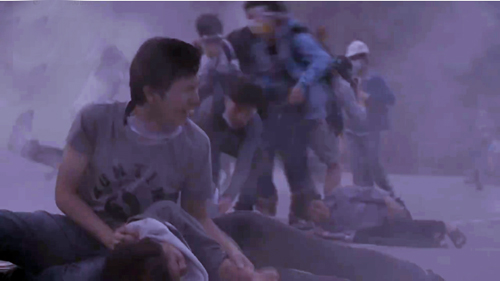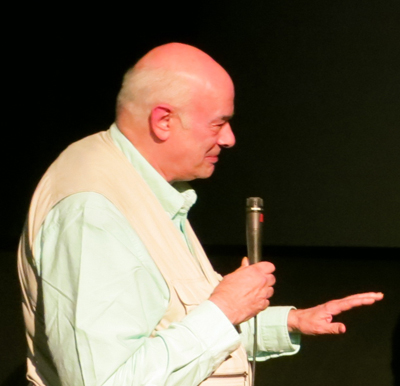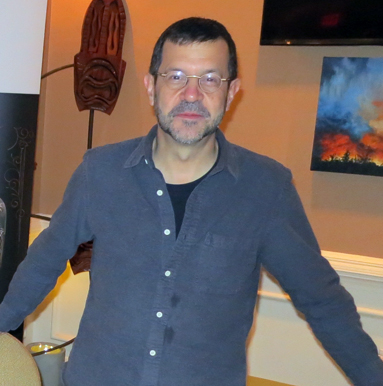Dragons, tigers, and two programmers
Tuesday | October 18, 2016 open printable version
open printable version
Yellowing (Chan Tze Woon, 2016).
DB here:
It was Asian film that brought me to the Vancouver International Film Festival in 2006, when Tony Rayns asked me to serve on the Dragons and Tigers awards jury. Ever since, Kristin and I have been returning; Tony made VIFF North America’s prime venue for cutting-edge Asian film. Name a major director from the region, and you’ll find that Tony scouted his or her early work for Vancouver.
For some years now, Tony’s co-programmer has been Chinese cinema expert Shelly Kraicer, who has been no less energetic in seeking out exciting new films. You can survey their track record by scanning our VIFF blog entries across the years.
Out of the many films in this year’s D & T retrospective, here are five that I especially admire.
Genres redux
Godspeed.
Across his career, Kore-eda Hirokazu has been a genre pluralist, but in recent years he seems to have settled into the shomin-geki, the bittersweet tale of lower-middle-class life. On the heels of Our Little Sister comes another family dramedy, After the Storm.
Once a prize-winning novelist, Ryota (the lanky, lantern-jawed Abe Hiroshi) is now a racetrack addict and a cheap detective not averse to shaking down high-school kids. After his father dies, and under the jaundiced eyes of his mother, he makes feeble efforts to reunite with his divorced wife and his baseball-playing son.
As usual with Kore-eda, everything flows in simple, unforced fashion, with every shot trimly composed and expertly timed. The emphasis falls on the actors, particularly as they’re captured in mundane activities. Ryota’s mother and sister are first seen writing thank-you notes to people who came to the funeral; he swills in fast food and throws away money on lottery tickets.
Ryota is one of Kore-eda’s most objectionable protagonists. He uses his admittedly minimal surveillance skills to spy on his wife, and he tries to swipe a family scroll to pawn. In an American film, this unlikable loser would pass through an arc that makes him caring, sharing, and on the road to rehab. Instead, as in many Japanese films, the unhappy character relapses into childhood—here, curling up with his son inside a playground octopus during a typhoon. It’s his effort to mimic a bonding moment with his father, but does it succeed now? Kore-eda isn’t betting on it.
Altogether less tranquil is Godspeed, from the Taiwanese director Chung Mong-hung. Chung has given us the horror film Soul (2013), the well-received Fourth Portrait (2010), and the lively Parking (2008), which I reviewed at an earlier VIFF session.
Godspeed is a Tarantinoish excursion into the underworld. It alternates violent scenes of betrayal and reprisals with comic interludes involving a drug courier and the taxi driver he’s hired to carry him to meet the bosses. The film is made with great panache, but for me what makes it noteworthy is that the driver is played by the great Michael Hui, dean of sour Hong Kong social satire.
Hui made his name as a television star before switching to films like The Private Eyes (1976), Security Unlimited (1981), and our favorite, Chicken and Duck Talk (1988). Godspeed revives Hui’s comic persona, the tight-fisted, corner-cutting bargainer who isn’t as clever as he thinks. As Old Xu, he reminisces about Hong Kong traffic and marital woes while trying to wangle a high fare from the phlegmatic, not overbright drug mule. Their misadventures—stumbling into a funeral, being stuffed into a car boot—serve as a counterpoint to the drug war escalating around them. No masterpiece, Godspeed is a beguiling exercise and a welcome return to a legendary and apparently ageless figure of Chinese cinema.
Mysterious, and fun
Another year, another stroll through Hong Sangsoo’s garden of forking paths.
With compositions that are about as banal as they can be, the films don’t aim to dazzle us pictorially. (Nice lighting, though.) The basics are really basic: Straight-on angles, fixed long take two-shots, simple come-and-go pans, an occasional and inexplicable zoom. These are his tools.
Dialogue and performance drive the action, which consists mostly of chance encounters and conversations in cafés, bars, restaurants, and bedrooms. His characters are students, artists, and film directors (usually fairly pretentious ones). Romantic hookups emerge, only to dissolve or play themselves out in parallel worlds, the whole presented in a “stacked” arrangement of modular scenes.
These scenic blocks display an obsessive, almost never mechanical, recourse to split viewpoints, recursive time schemes, mirror inversions, and whimsically varied replays. I’ve argued earlier that these permutations often test our faulty memory for exactly what transpired in a scene many minutes before, but it should be noted that sometimes, as in the last stretch of Oki’s Movie (2010), he’ll set the variations side by side.
Or maybe just side by side in your head. If the auteur theory didn’t exist, it would have to be invented to account for the effect of Yourself and Yours. In any other movie, when a man recognizes a young woman in a café, and she says he’s mistaken her for her twin, we might be inclined to take it as a brush-off. In a Hong movie, the scene makes us think back through all his other plots that have relied on doubling. So maybe this time he’s found a new variation? Has he got an actual pair of twins who will circulate through the scenes, constantly being taken for one another?
Suffice it to say that the young woman (women?), repeatedly encountering three men who are attracted to her (them?), becomes (become?) the pretext for the usual Hong mockery of male vanity and insecurity. The lackadaisical painter Youngsoo is worried about his girlfriend Minjung, who drinks more than he’d like. Moreover, his friend reports that she’s been seen with other men. Quickly enough, we spot her sharing drinks with an older man and a film director—who discover that they are old classmates. “This is mysterious,” the director remarks, “and fun.” None of the would-be Romeos notice that the lady in question is reading Kafka’s The Metamorphosis.
Hong always has another card up his sleeve, and Yourself and Yours, while not as ingenious as his previous entry Right Now, Wrong Then (2015), is satisfyingly teasing. It also yields one of the most flagrantly self-indulgent trailers I know: faithful to the movie, but frustrating in just the right ways.
Taking it to the streets
When college students en masse join a movement for social change, their positions tend to be vindicated in the long run. In the United States, students were right to support movements against nuclear proliferation, against racial discrimination, against American involvement in Vietnam, for women’s liberation and LGBT rights, against the invasion of Iraq, and, right here in Wisconsin, against Republican union-busting and voter suppression. The same pattern can be observed around the world, in student protests in Europe, South America, and Asia. Elders deride students as naïve, but more often than not, student activists critical of the status quo get principled politics right.
Why? I suspect several causes, including the fact that many (not all) students are reading, thinking, and learning while the general populace trudges through the dull compulsion of everyday labor. College flings together students from many backgrounds and may open eyes about how other people live. (Right-wingers worry too much about liberal professors indoctrinating students. In my experience, students are more influenced by their peers than by the likes of me.) And of course the flexible scheduling of college days allows motivated students the time to engage in political action.
Whatever the causes, it’s no surprise that in Hong Kong, the street protests running from September through December of 2014 were launched by young people. In August the mainland’s Communist Party decreed that instead of direct election of the territory’s Chief Executive, candidates would be chosen by a nominating committee comprised of businessmen and politicians sympathetic to Beijing. In effect, this guaranteed a puppet leader of the type all too familiar in the territory. Students responded by organizing actions similar to the Occupy movement in America. With surprising speed, civil disobedience and sit-down occupation spread through downtown areas of Hong Kong Island and the Kowloon Peninsula.
Hong Kongers were long considered indifferent to politics, only concerned with scrambling to get ahead and make money. But the world had to notice when tens of thousands of students and ordinary men and women built vast encampments in the streets in front of chic shops and noodle restaurants. Wearing yellow ribbons and hard-hats, and armed with umbrellas to protect them against sun, rain, and tear gas, they were apparently ready for a long stay.
This epochal event in Hong Kong history is documented in Yellowing, a new film by Chan Tse Woon. It was made under the auspices of Ying e chi, a filmmaking collective that has been working since the propitious year 1997, when the British turned the territory over to the People’s Republic. Although framed as a diary, it’s basically a cinéma vérité account of moments and vignettes of the Umbrella Revolution. The voice-over narration is keenly personal, beginning with home-movie footage of Chan’s childhood and youth, interrupted by his memory of repeated promises that democracy would soon arrive.
Loosely organized, Yellowing offers no systematic chronology of events à la a PBS program. It’s defiantly local, a snapshot album for Hong Kongers who will recognize each phase of the movement. At the start, some gorgeous nighttime cityscapes are shattered by confrontations with police (“Police, retreat,” the students chant) and conversations with student organizers in their down time. In the two hours that follow, we spend a lot of that time with young people like the ceaselessly beaming Rachel, who’s now considering becoming a civil rights lawyer. We see one boy passing out wristbands reading, They can’t kill us all.
Students set up tents, squat in pounding rain, organize English classes, and run supply chains across the vast areas of occupation. There are clashes with police and civilians. (“Your flesh and blood belongs to your family,” a man charges.) Chan’s camera captures, helter-skelter, assaults from cops and street gangs. There are camera duels, with police filming demonstrators while demonstrators film police. Chan’s voice-over says that he thought his camera would protect him, but he still gets punched in the face. The occupiers practice tactical evasion and passive resistance, but there’s no effort to heroicize them. Many are crying as police lead them away.
Despite the almost casual presentation, you realize how much these kids are risking. Many are poor, some are trying to hang onto a job, and nearly all realize that this will change their lives. “Even if we lose this fight, we’ll lose together.” As for the angry citizens wearing blue ribbons declaring support for authorities, the students are sympathetic: “Don’t you think they need democracy too?”
The film circles back to the opening, with Daddy-cam shots of children. We hear Rachel writing in reply to a professor who had urged the students to give way for the sake of “security,” and to stop being tools of “foreign subversion.” The film lingers on her cheerful, polite suggestion that Mainland domination has replaced British colonialism, and that the children of the future deserve better.
Most of our politicians and all of our plutocrats will never know the sort of courage that these young people displayed with modest, good-humored tenacity. Unarmed—unlike the Y’all Queda fraidycats who occupied our Oregon wildlife refuge—these unprepossessing kids stood a very good chance of being brutalized by a government not known for recognizing the niceties of due process. You feel proud of the young people of Hong Kong while watching this heartbreaking, hopeful film. As often happens, the students were both righteous and right.
Not hope, fear
Ying e chi has often worked with theatres to show independent films, but Yellowing has been denied a theatrical release. Instead, Variety reports, producer Vincent Chui has arranged for guerrilla screenings. Five ticketed shows were held at the Hong Kong Film Archive, in order to qualify for this year’s Hong Kong Film Awards.
The resistance to Yellowing doubtless owes a lot to the controversy surrounding another film, Ten Years (2015). It won astonishing success in local theatres. According to Maggie Lee in Variety, it cost only US$65,000 but earned nearly $800,000 before Beijing realized how subversive it was and blasted it as a “thought virus.” Ten Years was nominated for a Hong Kong Film Award, which made the PRC cancel television coverage of the ceremony. When the film won the Best Picture prize, shock waves went through the film community, and it was denounced by producers and executives. It was soon cast out of theatres, but screenings continued in community centers, churches, and outdoor venues. It’s slated for a DVD release soon.
Ten Years consists of five shorts linked by the premise of local life in 2025. In its dystopian portrayal of Mainland domination of Hong Kong, it’s a fairly direct outgrowth of the Umbrella Revolution. But if Yellowing documents the movement’s hope, this film exposes, as many commentators have noted, fear.
One episode, “Extras,” dramatizes behind-the-scenes scenes political machinations as a sort of noir comedy. Two hapless thugs are hired to stage an assassination attempt that will arouse public support for a new security law. While the men rehearse their gun choreography, the puppeteers debate whether killing or wounding the targets would play better in the media.
Other episodes are more concerned with the cultural impact of Beijing’s dominance of local life. “Season of the End” presents scientists searching rubble for signs of now-vanished Hong Kong life, shot in ominously clinical detail. “Dialect” presumes that Mandarin is becoming the official language of the territory, and we see a taxi driver struggling to cast off his Cantonese. “Local Egg” also centers on language. Here a shopkeeper is forbidden to use the word “local” because it suggests those political factions struggling to keep Hong Kong distinct, or maybe pushing it to become independent. In an echo of the Cultural Revolution, this episode shows schoolkids in uniform arriving with iPads to check shops’ compliance with the list of forbidden words and retail items.
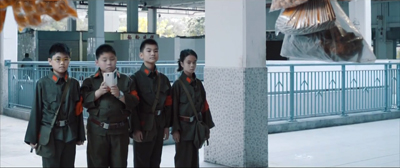
The most emotionally wrenching episode, “Self-Immolator,” is a pseudo-documentary. Startling scorch-marks on the sidewalk are the traces of someone who burned to death in protest of government oppression. Through talking heads, a collage of demonstration footage, and some investigation, the film traces how a young man’s hunger strike led to the mysterious self-immolation. Several candidates for the self-sacrifice are canvassed before, in a break with the documentary frame, the protest suicide is shown. In the conclusion, an umbrella is seen aflame, perhaps forming a requiem for the 2014 protests.
Ten Years is a good example of how a film can have social importance because of the moment at which it emerges. Along with Yellowing, it will be a lasting memorial to the struggles of Hong Kong people to introduce democracy to China.
Thanks to Tony and Shelly for all their work in setting up these screenings. In addition, Kristin and I are grateful to Alan Franey, PoChu AuYeung, and Jennie Lee Craig and their colleagues for making our VIFF visit so enjoyable and enlightening. Special thanks to Tallulah for cheerfulness and Lillooet for the waffles.
Thanks to our regular attendance at VIFF, we’ve discussed many of Hong Sangsoo’s films; see the director category.
The development of the Umbrella Revolution is traced in this long New York Times story. Last August, accused student leaders got surprisingly light sentences. Some of the “localists” and Occupiers won places in the Legco elections and are expected to make waves.
Tony Rayns and Shelly Kraicer.












